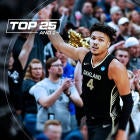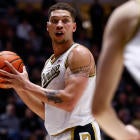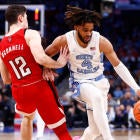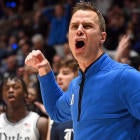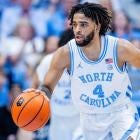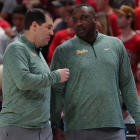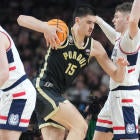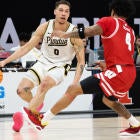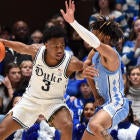SAN DIEGO -- There were 40 coaching changes in college basketball this past spring. Among the smaller-school sect, perhaps the most interesting, challenging and surprising: Lamont Smith's arrival at San Diego.
He's a 39-year-old, well-travelled addition to the program that let go of Bill Grier after eight seasons. Grier reached one NCAA Tournament in his tenure, his first season, then averaged 13.6 wins from 2009-2015. But remember, Grier also endured a point-shaving scandal involving the school's former all-time leading scorer, and in spite of that, prevented the program from bottoming out, let alone taking on any NCAA sanctions.
It's never a good thing when, contemporarily, your program is primarily known for rogue players' affiliations with criminals and a penchant for fixing games. But San Diego's been able to mostly distance itself from that saga and not let it stick to the school. Then again, that's really only been possible because it's San Diego basketball. It has no identity, just four NCAA Tournament showings to its name -- and that's something Smith, an alumnus, is very much aware of. He knows even most casual college basketball fans couldn't identify San Diego's nickname -- The Toreros!
Smith has thought about all the seemingly little stuff that adds up to a name, to a brand, to a recognizable label for his school. He's deliberated over what he wants San Diego's jerseys, team shirts, all of it to read. "USD"? "SD"? "San Diego"? "University of San Diego"? What colors, what fonts, how big, all of it.
"We're irrelevant right now in terms of basketball in this city," Smith said in a recent sit-down with CBSSports.com. "You can come to our games and you'll see it. But the model for us, where I get excited is: When I played for San Diego, we'd play San Diego State and nobody would come their games. Now they have a 12,000-seat arena over there. We have a 5,000-seat arena. If we can get some mojo going, I believe people will come out and support us and help get us relevant."
Smith arrives with a charismatic energy, a recruiting philosophy that won over the powers-that-be and a pragmatic view of what his alma mater is. USD is a tough job -- among the toughest in the conference -- despite its location.
Or maybe because of it.
"The place has been very chill," Smith said. "We talk about this all the time with our team -- getting San Diego-ized. Everybody gets here and it's just laid back. 'Ah, yeah. We won, we lost. No big deal. People didn't go to the game, no big deal.' It's just a laid-back place."
The double-edged sword of San Diego is the instant lure of the locale, but also how the area's vistas, beaches, opportunities and way of life can stymie the program from having real fire and desire to compete. That's in large part why Smith believes USD has never been a consistent, even fleeting, top-five program in the West Coast Conference. Few schools anywhere have as many lovely distractions as USD.

|
Lamont Smith played for USD from 1994-99
|
| Back to school | |||
| Active coaches entering their fifth season and beyond at their alma maters | |||
| Coach | School | Years | Record |
| Jim Boeheim | Syracuse | 39 | 858-333 (.720) |
| Howie Dickenman | CCSU | 21 | 278-286 (.483) |
| Lorenzo Romar | Washington | 13 | 270-159 (.629) |
| Roy Williams | UNC | 12 | 332-101 (.767) |
| Mick Cronin | Cincinnati | 10 | 185-117 (.613) |
| Matt Painter | Purdue | 10 | 212-124 (.631) |
| Lewis Jackson | Alabama St. | 10 | 157-156 (.502) |
| Scott Cross | UT-Arlington | 9 | 153-128 (.544) |
| Bob Huggins | W. Virginia | 8 | 175-101 (.634) |
| Marty Simmons | Evansville | 8 | 126-134 (.485) |
| Derek Kellogg | UMass | 7 | 126-101 (.555) |
| Brian Katz | Sac. St. | 7 | 77-130 (.372) |
| LeVelle Moton | NCCU | 5 | 107-53 (.669) |
| Dave Rice | UNLV | 4 | 89-47 (.654) |
| Marty Wilson | Pepperdine | 4 | 58-77 (.430) |
| Mitch Henderson | Princeton | 4 | 74-46 (.617) |
| Rob Krimmel | St. Francis | 4 | 31-61 (.330) |
| Bryce Drew | Valparaiso | 4 | 94-42 (.691) |
"That's the biggest challenge, I think," Smith said. "I've seen it as a player here. Shit, I got it a little bit, too, as a player. You come here, you've got a Division I scholarship, you want to beat Gonzaga, you want to beat BYU. Then you get to school here and something happens. ... You get a girlfriend or you don't play or whatever, and because this place is awesome, you can go to the beach, go downtown, go to Del Mar, go hiking, go fishing. Basketball becomes less of a priority. You aren't in the gym, doing the things you need to do."
And there's that word, the cliché that he's trying not to use when it comes to adjusting USD's projection: culture.
"I hate that word," Smith said. "That we've gotta 'change the culture.' Like mine is right and (Grier's) was wrong. ... We have made it a purpose that we may not get five star guys here, which we won't, but we're going to get two-star and three-star guys here with a chip who want to get better and better and better in the gym. Basketball is their identity. That's the guys I want. Otherwise, you can very easily go the other way."
Smith was brought on in part to fight the area/territory battle with San Diego State, a Mountain West team that's become a top-25 program in the country in the past 15 years under Steve Fisher. It's been one of the all-time amazing program constructions in the history of D-I. And now Smith has to try to compete on that level within city boundaries.
"If you look at the two institutions, they are very different," Smith said. "We don't typically recruit the same type of guys, just from an academic standpoint. They've done more transfers, which we still want to do, but there is enough pie to eat with everyone here. And as much as it is an outdoors city, they still do love sports here."
The two programs will play an unprecedented game in December, at Petco Park, home of the San Diego Padres. It's a unique idea that doesn't require a massive boat and therefore won't require constant toweling of dew off the court's surface. It'll be the first time any college basketball teams have played a game in an outdoor baseball stadium, and it's going to be a pretty sight and a great, quick boost of PR for the Toreros.
Smith's challenge is two-fold: SDSU and of course the league battle on the WCC mountain with Gonzaga, let alone BYU and Saint Mary's. But it's not about catching Gonzaga, it's about finishing top-three, maybe top-four. That's Smith's goal: to be in the conversation near the top. Give it three, maybe four years, and USD can be there. The WCC is good enough -- it's set up to be a multi-bid league year in, year out -- that it can send at least two, but sometimes three, teams to the NCAAs.
That's where San Diego needs to eventually find itself. The good sign is, San Diego didn't make a unique choice when it went with Smith, at least in terms of his background. There are more than 30 alumni currently coaching at their alma maters in D-I men's basketball right now. Since 2000, at least a dozen other coaches were hired away from their former schools after showing success. Even fewer have been fired in that time span. You pick a former player, the odds are that coach will have a desire and ability to bring success to your school. This is encouraging for Smith and for USD.
Smith has been cultivated for this opportunity not just because he went to USD, but because he also was on staff at three private schools (Saint Louis, Saint Mary's and Santa Clara) before getting his first head-coaching opportunity. As for international recruits, he's got a lot of experience with Saint Mary's, and even at Arizona State, where the staff landed players from Denmark and Serbia in addition to the Australian pipeline.
"I'm overcome with humility," Smith said. "I've been fortunate to be at some places where we started a program that was in worse shape than this, but the same type of program. Saint Mary's is what I'm really referencing here. There's a madness to it, and I watched Randy Bennett do it. I was in the trenches with him for six years. I would be a fool not to duplicate some of the same things he tried to do. Now, we're not Saint Mary's. We're not the same institution. But there are some things that correlate."
Saint Mary's was Bennett's first chance at being a head coach. He's still there, and Saint Mary's is without a doubt one of the five best programs west of the Rocky Mountains. Smith's dream is to duplicate that. In fact, SMC was an even worse program in 2001, when Smith joined, than San Diego now.
To see what Saint Mary's has become is, for Smith, to know what San Diego can be. The longview victory is for people to know what a Torero is without ever having to define it.













